Question and Answer — April 2013
Neil addresses your gardening questions here each issue. He does require a photo for each question due to the visual nature of e-gardens. Questions of greatest reader interest will be given top priority. Neil answers 5 to 15 questions here each issue. Click here to send us your photo and question.
Question: Our landscaper planted these Clara Indian hawthorns in 2010. Some of the plants are developing brown spots on their leaves. Are they harmful to the plants? J.J., Parker County.
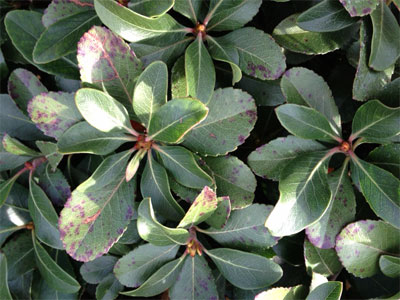
Answer: Unfortunately, that does look like the beginnings of Entomosporium fungal leaf spot. It’s the same fatal disease that has riddled redtip photinias in recent years. My suggestion would be that you blow last year’s leaves out of the way as they fall in the next week or two, then watch the new growth from 2013 to see if the leaf spot shows up on it. If it does, you’ll need to think about replacing them in the future. Hopefully my ID is wrong and it’s just some form of moisture stress from last summer.
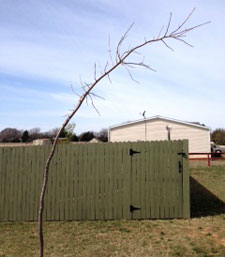 Question: We have had this Chinese pistachio for 5 years. The prevailing wind is out of the south. Even though we have moved the stakes higher and higher, the tree still bends. Should we continue to stake it for a few more years, or will it ever be straight? Our other trees are doing fine. J.T., Gainesville.
Question: We have had this Chinese pistachio for 5 years. The prevailing wind is out of the south. Even though we have moved the stakes higher and higher, the tree still bends. Should we continue to stake it for a few more years, or will it ever be straight? Our other trees are doing fine. J.T., Gainesville.
Answer: Trees that are out-of-plumb like this will never become straight unless they are dug and reset perfectly vertically or cut back almost to the ground and allowed to send up new sprouts, one of which would then be saved as the new trunk. Your tree is too badly stooped to be dug and reset, so your best option will be to cut it off a couple of feet above the ground, where it begins to bend off to the right. Try to find remnants of a branch or a bud, and trim 1/4-inch inch above it. Several new shoots will emerge and start growing up straight. Later this spring, as you can determine which one of them will give you the most vertical trunk, you can remove the others. If there is more than a 1/4-inch stub, make a fresh cut in the old trunk. Within a couple of years, as the trunk grows thicker, it will absorb and conceal the stub, and you’ll have a great tree. It should happen fairly rapidly, since the roots will not be impacted by the trimming. They’ll be able to send all of their “oomph” into the new top growth. It will look rather sad for a couple of years, but you’ll end up with a handsome specimen after that.
Question: We have Japanese boxwoods on three sides of our house. They did well for 35 years, but four years ago we had foundation work done. Five new 5-gallon plants were set out in the beds. Plant #2 nearly died at the end of the first season. Now, plant #3 is in similar decline. Will these recover if I prune them carefully now? S.S., Paris.
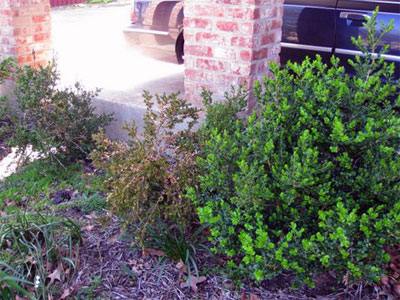
Answer: The damage I’m seeing looks like the plants got too dry at least one time. Try pruning them back significantly, probably as by as much as one-third to one-half. Apply a high-nitrogen fertilizer to give them a boost for their regrowth, and keep them moist at all times. Just to have mentioned it, nematodes are a possibility when boxwoods struggle. You might want to check roots alongside the worse of the two plants. If you see knots on the roots, the course of my answer would change. We don’t have a control for nematodes once they attack plants like boxwoods, violets, ajuga and tomatoes. You have to replant with a species that isn’t impacted by them. Dwarf yaupon hollies give a similar look to a garden, yet they do not have issues with nematodes. This probably is not nematode-related, so hopefully that won’t be a direction you’ll have to take. (Nice to hear from you, friend.)
Question: My daffodils were planted in 2007. They bloomed profusely until the past two years. The bed is much larger, and all of the daffodils look like this. We have more shade now, because the trees have gotten larger. What can we do? S.P., Mt. Pleasant.
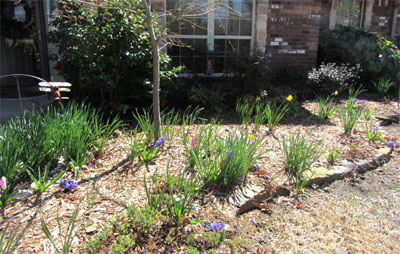
Answer: Large-flowering daffodil hybrids typically stop blooming within the first couple of years after they have been planted. They produce only foliage, and sometimes they produce a great deal of that. You could try digging and dividing them in late August or very early September. The shade probably isn’t a factor, since the bulb foliage is probably gone soon after the trees leaf out. As you plant more daffodils, you might concentrate on varieties like Ice Follies, Carlton, Cheerfulness, Geranium and others that are known to be really good rebloomers. The smaller, early-flowering jonquils that abound in East Texas would be outstanding choices as well.
Question: Several leaves on my year-old aralia have developed spots like the ones on this leaf. I end up just trimming them off, as you can see on the plant’s trunk. The plant sits below the roof overhang, so I’m wondering if it’s water-related. K.Y., Richardson.
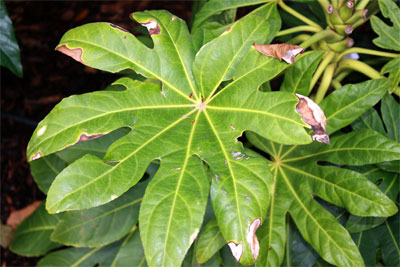
Answer: You are probably correct. This looks like marginal burn brought on by letting the plant get too dry at least one time. I’m not aware of any fungal leaf spot that bothers fatsias, and fungal diseases normally don’t show up only around the margins of plants’ leaves. (They’re more random.) If the spots return this year, you’ll know to apply a fungicide. My bet is that you won’t see it if you’re attentive to watering.
Question: We have a large pecan tree that is critical to our landscape and our house. It is 10 feet in circumference. Ten years ago a tree man removed two large branches. Recently, to our dismay, we noticed that there is a good bit of decay where those limbs were. Should we fill the decayed areas? Should we cover them? What can we do to stop additional rot? P. and A.K., northern Collin County.
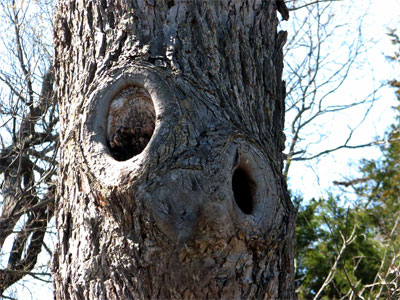
Answer: To get the best possible help here, I went to my friend Steve Houser of Arborilogical Services in DFW. Steve and Bill Seaman from their company share the wonderful tree information here in each issue of e-gardens. Here are Steve’s suggestions. (Thanks, Steve!)
“As a general rule, arborists do not recommend filling cavities in trees or decayed areas. There is also not an effective way to repair, correct or reduce, rot and decay in trees. You may have noticed the tree is growing new tissue on the sides of the cut wounds which will eventually grow together to seal off these wounds. As it does, this part of the trunk becomes stronger to help offset the loss of strength from the decay. It is a part of a tree’s natural response to wounds. If you are concerned about the strength in this area, it could only be fully evaluated by a professional arborist fully accessing the conditions related to the entire tree as well as the site.”
Question: We bought our house out of foreclosure. The lawn had not been tended for at least two years. There were many trees. We had three of them removed to allow more light. Now we have a combination of weeds and horseherb growing in spots. I’d like to make horseherb the groundcover. I like its foliage and cheerful yellow flowers. I tested my soil, and it showed it to be low in all three elements. How can I make the transition to horseherb? What fertilizer should I use? R.B., Fort Worth.
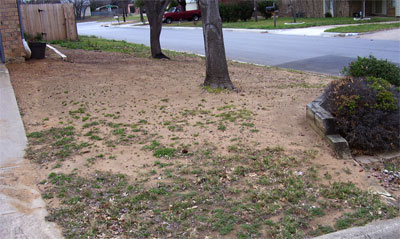
Answer: Anytime you plan to put groundcovers into your landscape, you owe them the best possible soil preparation. After all, they’re going to be growing in that soil for a long period of time. Rototill to a depth of 8 to 12 inches, then layer in several inches of organic matter (sphagnum peat moss, rotted compost, well-rotted manure, finely ground pine bark mulch, etc.) and rototill again. As for horseherb as a featured groundcover, do remember that it’s bare for almost half of the year. The top growth dies to the ground with the first freeze. It’s also invasive into other parts of your and your neighbors’ landscapes. If you have enough sunlight, turfgrass will always be the easiest groundcover to maintain there. If you don’t want to do that, consider Asian jasmine or purple wintercreeper euonymus. Use a quality high-nitrogen fertilizer that contains 50 percent slow-release nitrogen.
Question: We don’t have a lot of sunlight, and the grass won’t grow in this part of our yard. We’re considering Asian jasmine. We love it, and we have it elsewhere, but in this spot, it would be hard to get tree leaves out of it in fall. What other choices might we have? S.M., Arlington.
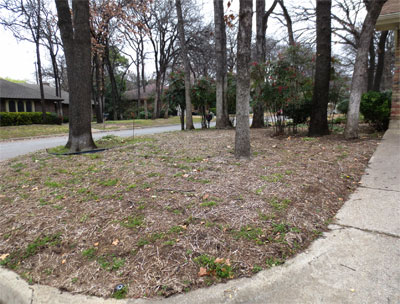
Answer: My go-to groundcover in the shadows of our large pecan trees is regular mondograss (not dwarf). It grows to 6 to 8 inches deep, and it has a lovely fine texture. It’s quick, it’s dense, and it’s easy to blow or rake leaves out of it. Once you get it started, you can easily propagate your own by digging clumps and breaking them into pieces. Plant tennis-ball-sized clumps 8 or 9 inches apart checkerboard-style into soil that has been tilled to 8 inches and amended with organic matter. Keep the planting moist, and the mondograss will cover the area fully within 15 months. If you want something taller, its sister liriope does well. Purple wintercreeper euonymus is another candidate for both sun and shade, but it has the same issues as Asian jasmine, in that its stems will snag fallen leaves.
Question: I have a full sun backyard, and I’d like to grow perennials. Can you list those of varying heights that I ought to consider? Also, what type of garden design should I consider for them? J.K., Allen.
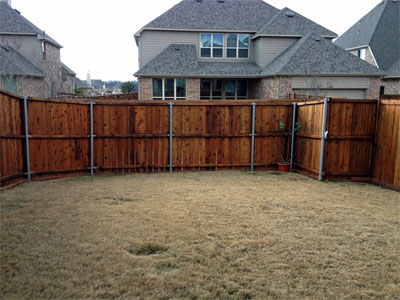
Answer: Designing a lovely and successful perennial garden is a daunting and lengthy task. However, here are some basics. Any perennial garden needs to begin with structural evergreen shrubs that will carry the good looks though the “down” season of winter. As you decide the types that you like most and set out to include them, let the shrubs be the “bones” of your design. Plant perennials in pockets of color, so something will always be popping into flower. Most perennials bloom only for two or three weeks, as opposed to the several months you get out of annual flowers, so planning and positioning of the perennials is critical. As for the best types and how you might arrange them, I’m going to do something I rarely do here in my answers, and that is to refer you to something I have for sale. Our 15 x 30-inch poster (full color, heavy cardstock) titled “120 Best Perennials for Texas” was developed with the help of Jimmy Turner from the Dallas Arboretum. It took me one month to get all the data researched, sorted and put in order. It’s a giant chart telling how tall and how wide each plant grows, what colors its flowers may be, and what months it blooms, along with a ton of other info. You can buy the poster separately for $10 plus $2 postage, or we have a special offer featuring all four of our posters AND a subscription to our magazine for just $34 plus $3 postage. Total value: $71.95. Here is a link to our website page to buy the poster. Or, here is the special offer for all of the posters and the magazine.
Question: Neither St. Augustine, ivy nor jasmine has survived in this area. It’s in full, hot sun. Any suggestions? L. and B.M., San Angelo.
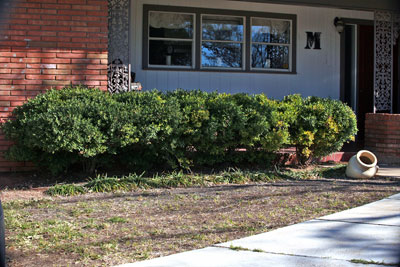
Answer: Ivies aren’t going to handle the sun. If you had Asian jasmine, that was a good choice. It probably got too dry at some point. The plants actually don’t wilt, so it’s easy for them to go past the point of no return. I would try it again, or I’d go with purple wintercreeper euonymus. It’s a less common trailing groundcover that many of us have begun using much more often.
Question: Why would my crape myrtle’s stems be black? What can I do to remove it? D.W., no city given.
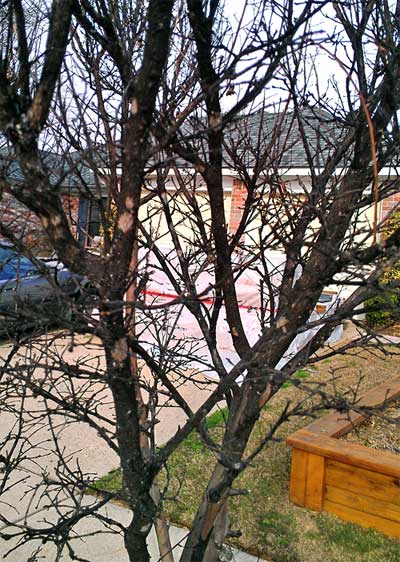
Answer: That’s sooty mold, and it by itself is harmless. However, as you noted, it’s disfiguring. Control it by stopping the honeydew drip that’s put out by aphids or crape myrtle scale. Apply the systemic insecticide Merit in late May. The insects also will not cause permanent harm to the plants, but they do give rise to the mold.
Question: My lavender plants look very tired. I have about 12 different types. Some stuck around long enough to bloom, but only one plant remains. Can I grow lavenders here in Tarrant County? I did amend the soil to provide drainage. R., Fort Worth.
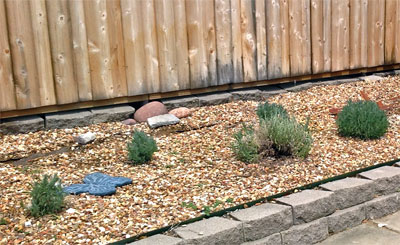
Answer: Lavender does need perfect drainage, so plant it in a loose, sandy loam soil mix. Mound the planting bed up by several inches. You’ll be more likely to succeed if your plants get a bit of shade from the afternoon sun, although morning sun is important. Lavender is not an easy plant to grow in your part of Texas. Summer really takes a toll. Many of us have chosen to move on to other, more rewarding gardening adventures.
Question: I assume these are tree seedlings, but I’m wondering if they’re worth saving. I have no hollies like this nearby. Are they worth replanting? L.J., Grand Prairie.
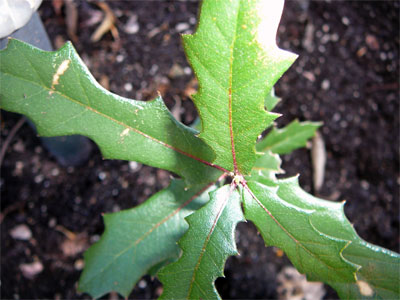
Answer: If you want live oaks, transplant them. This is juvenile foliage. Almost anyone who grows live oaks will eventually have seedlings that look like this. Once the trees attain 12 to 18 inches in height, the newest leaves will begin to develop into their normal shape. If you’re going to dig and move these to pots, do so immediately, before it gets any warmer.
